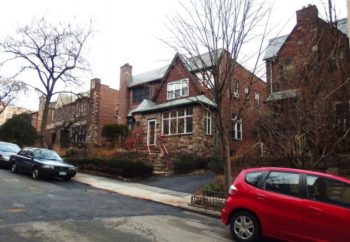
Houses on West 217th Street demonstrate the suburban character of the proposed historic district. Image Credit: NYC Landmarks Preservation Commission
The proposed historic district highlights homes with suburban characteristics rarely found in Manhattan. On September 25, 2018, the Landmarks Preservation Commission unanimously voted to calendar the proposed Park Terrace West-West 217th Street Historic District in the Inwood section of Manhattan. The proposed historic district consists of fifteen houses along West 217th Street between Park Terrace West and Park Terrace East and along Park Terrace West between West 215th Street and West 218th Street.
The fifteen houses are located on 527 West 217th Street to 545 W 217th Street, 77 Park Terrace West to 81 Park Terrace West, and 91 Park Terrace West to 97 Park Terrace West. According to the Landmark Research staff, the fifteen houses were constructed between 1920 and 1935 by Moore & Landsiedel, Benjamin Driesler, Louis Kurta, C. G. de Neergard, and A. H. Zacharius. The houses are a mix of free-standing or semi-detached two-story brick buildings with detached basement garages. The houses are Tudor Revival and Colonial Revival styles with Craftsman-style details.
Landmarks is considering the properties for the historic district due to their “uniform scale, consistency of architectural styles and building materials, and landscaped gardens that work with the unique topography of this part of Inwood.” The suburban character of the homes is rare for Manhattan. The houses have a high level of integrity, with only minor alterations such as window replacements and small changes to the facades.
Inwood was once farmland at the northernmost region of Manhattan. The proposed historic district was once a part of the Isaac and Michael Dyckman farm. As New York City expanded, the land was divided, and in 1851 the land was sold to John Ferris Seaman and his wife, Ann Drake-Seaman. Subsequently, the couple constructed a mansion on the estate.
In 1878, Drake-Seaman passed away and left the estate to her nephew, who sold off parts of the estate. In 1906, the area around the estate developed as a residential neighborhood when the Interborough Rapid Transit (IRT) subway lines (the modern 1, 2 and 3 trains) connected Inwood to the rest of Manhattan.
The residential neighborhood continued to grow into the 1920s when the IND subway lines (now the A, B, C, D and E trains) were constructed. As the neighborhood grew, many apartment buildings were constructed in Inwood. The homes within the proposed historic district were developed later than many of the surrounding large apartment buildings. As a result, the houses’ suburban Tudor Revival and Colonial Revival styles stand out from the large apartment buildings found throughout the neighborhood. The contrast between the houses within the historic district and the large apartment buildings that surround the district adds to the unique suburban characteristics of the historic district.
According to Landmark Research staff, three similar homes in the area were also considered but excluded because of too many stylistic and structural alterations. 83 Park Terrace West, which is the only building between 81 and 91 Park Terrace West, was also excluded for being a large apartment building that did not reflect the historic and suburban character as the rest of the historic district.
Landmarks will hold public hearings on the designation of the historic district at a later date.
LPC: Park Terrace West-West 217th Street Historic District, Manhattan (LP-2621).
By: Veronica Rose (Veronica is the CityLaw Fellow and a New York Law School Graduate, Class of 2018.)

